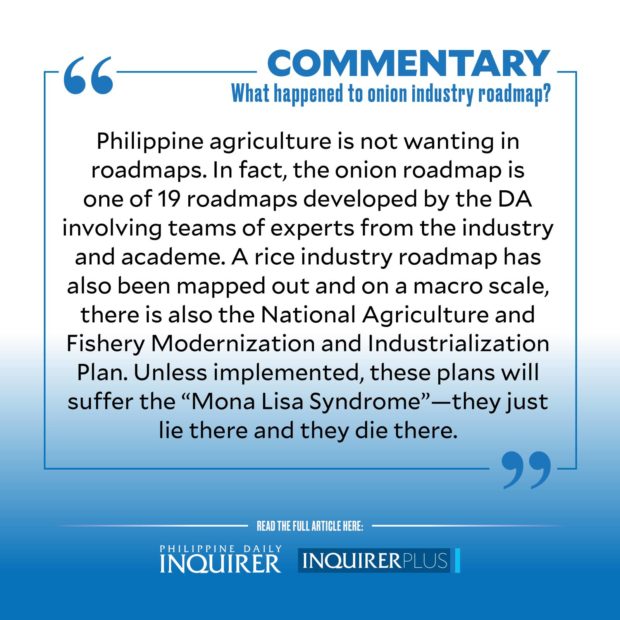What happened to onion industry road map?
In recent weeks, the skyrocketing prices of onions have been hogging the news and which, until this writing, have remained high. Explaining the issue, the Department of Agriculture (DA) says that there are many layers of traders which are pushing up the prices of local onions. Senators investigating the surge in onion prices blame a cartel that controls the supply. No less than President Marcos Jr. said that he will meet all stakeholders in the onion industry to discuss the issue of high onion prices. On this, former DA Undersecretary Fermin Adriano says that “there are structural, institutional and cultural reasons why there is a substantial difference between farmgate and retail prices.”
As a stopgap measure, the DA approved the importation of 21,060 metric tons of onions to fill a supply gap and arrest the spike in prices. Along with this, the department also declared that it would enable farmers to sell their produce directly to the market, eliminating the many layers of traders. Despite these efforts, along with the harvest season and entry of imported onions, retail prices of onions still remain high.
Amidst the foregoing and unknown to many, there is an Onion Industry Roadmap (2021-2025) which is part of the high value crops subsector road map developed by the DA. The road map outlines how the Philippines can address three major challenges: achieving self-sufficiency in the commodity while lifting farmers from poverty; the advent of the Asean Economic Community (AEC); and adapting to climate change.
The road map envisions “a modern, competitive, and profitable onion industry providing high quality, safe, affordable, and sustainable supply of onion to meet increasing domestic and export demand” and a mission to “ensure the production of and access to high quality, safe, and affordable onion throughout the year.”
To pursue these, the road map aims to: (1) increase production of yellow onion and shallots by 10 percent per year; (2) ensure food safety and enhance off-season production, seed systems, and storage facilities; (3) improve post-production and logistics facilities, strengthen marketing linkage and support services, and minimize production cost and postharvest losses; (4) strengthen analytical service laboratories, enhance pest and disease forecasting capability; (5) develop improved varieties, crop protection systems, and decision-support tools, and improve processing and value adding systems; and (6) organize the production sector and protect onion growers from losses due to disasters, pests, diseases, and other climate impacts.
According to the road map, for the Philippines to achieve onion self-sufficiency, it needs to increase production from 229,539 metric tons to 279,270 metric tons in five years by increasing area planted and yields. It will require promoting improved technology through the judicious use of inputs, farm mechanization, and shift to bigger and higher yielding varieties pursued through farm clustering. Growers will be encouraged to expand their cropped areas, supplemented with new areas, especially those with a different harvest period to support year-round supply. Likewise, irrigation facilities will be expanded to help increase potential areas for onion.
The road map targets the strengthening and federation of small producers organizations for group procurement, marketing, and efficient delivery of support services. Trading activities will be streamlined by eliminating unnecessary layers for exports and minimizing marketing cost. To implement these, the road map identifies strategic investments in: (1) capacitating producers and their organizations; (2) production support services such as seed support systems, machineries, and equipment; irrigation, rain shelters, input subsidies; (3) postharvest support (e.g., hangers and cold storage); (4) common infrastructure; and (5) strengthening regulatory services and research and development.
Philippine agriculture is not wanting in road maps. In fact, the onion road map is one of 19 road maps developed by the DA involving teams of experts from the industry and academe. A rice industry road map has also been mapped out and on a macro scale, there is also the National Agriculture and Fishery Modernization and Industrialization Plan.
Unless implemented, these plans will suffer the “Mona Lisa syndrome”—they just lie there and they die there.
——————
Dr. Rex L. Navarro is a member of the Coalition for Agriculture Modernization in the Philippines. He was associate professor and former director of the institute (now college) of development communication, University of the Philippines Los Baños.





















